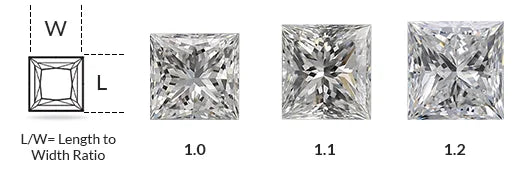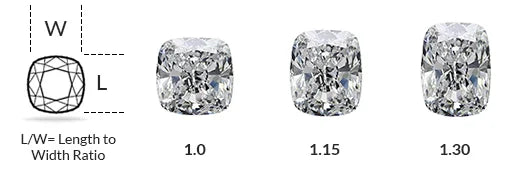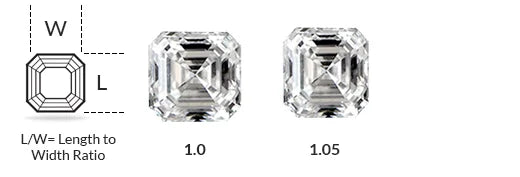Diamond Shape
Do traditional classics like round shape that are rooted in history just your kind of aesthetics? Or do you find the old school in you for falling for vintage emblems of love like Asscher and Emerald Shape? Or has the modern fashionista in you lately been eyeing fancy shapes like pear and marquise?
Whichever shape resonates with you more, you’d have to agree that it speaks volumes of your aesthetics, personality, and one-of-a-kind love. That’s why we consider it as something that breathes life to your jewelry. But what does a Shape truly stand for in technical terms? When do we really call it the soul of the Diamond? Isn’t it the same thing as the cut? Stop confusing yourself with all these questions because our Diamond Shape Education Guide has you covered with all the right answers.
What is a Diamond Shape?
Technically speaking, the shape of the Diamond can be defined as its geometric outline or form.
Some of the examples of shape are- round, oval, pear, marquise, cushion, emerald, princess, and heart. More than anything, picking a Shape is a matter of personal preference and your own cultural beliefs. Everything boils down to what works for you in terms of aesthetics and meaning that the shape carries.
The extent with which it influences the appearance of your Diamond needs no introduction.
Length-to-Width Ratio
You may have never imagined the kind of impact a length-to-width has on the aesthetics of the diamond shape. Technically, the length-to-width ratio of a diamond shape refers to the proportion between the length of a diamond and its width. We know you’re wondering “how is it even important?” Well, actually it affects how the diamond will look when viewed from the top.
Different diamond shapes have different ideal length-to-width ratios, and these ratios can affect the perceived size and symmetry of the diamond. For example, round diamonds are typically cut to have a length-to-width ratio of 1:1, which gives them a perfectly symmetrical, circular appearance. But for a cushion cut diamond, a length-to-width ratio between 1.3:1 and 1.5:1 is considered ideal, as it gives the diamond a soft, pillow-like appearance. So long story short, it impacts the overall shape and aesthetics of a Diamond more than you’d have thought.
Most Popular Shapes of Diamond
You’ve heard or seen these shapes, but do you actually know them? Come let’s find out!
-
Round Brilliant Diamond:
You may recognize it as a shape that brings together classic beauty and timeless elegance. This shape was first developed in 1919 by Marcel Tolkowsky, a Belgian mathematician and gemologist. Tolkowsky used mathematical calculations to create a shape that maximized the diamond's brilliance, fire, and scintillation. The result was the round brilliant cut, which has become the standard for diamonds all across the world. If you wish to get the most of the brilliance, we recommend giving preference to a higher graded cut for this shape.
Nothing comes close to the kind of sparkle that Round Brilliant Diamonds exude. They fit well with any style, be it solitaire or three stone and thus, are deservedly the most popular shape out there. -
Oval Shape Diamond:
We fondly call Ovals the elongated cousins of round shape. And interestingly, they are capable of giving round diamonds a tough competition in exuding brilliance. Their versatility knows no bounds since they are most commonly set in solitaire and halo rings, but never disappoint when set in other jewelry such as pendants and earrings.
If you didn’t notice already, Oval Diamonds are so popular because they can create the illusion of greater size and carat weight compared to round diamonds of the same weight. The best part is that they can deceive your eyes by making the fingers look longer and more petite as well (if that’s your thing).
Length to width ratio:
-
Princess Shape Diamond:
Bored of the typical round Diamonds? Enter- Princess Shape, the new go-to shape for women. It is characterized by its square or rectangular shape, but with pointed corners. Not only does its geometrical look set this shape apart, but its brilliance would never disappoint you. Tell us you haven’t been seeing this shape making its place in every other woman’s engagement ring (and hearts) already.
Though, you can expect the corners of this shape to display some color. So, you may have to pay attention to the color grade. Apart from that, a protective setting would guard the corners from chipping or damaging from the corners (which case be the case with princess cut). But the plus point of investing in this shape remains that you don’t have to break the bank as much as in the case of round diamonds.
Length to width ratio:
-
Marquise Shape:
Lay a good eye on this shape and you will find it to resemble a smile. And this interesting resemblance makes it one of the most unique shapes out there. Physiologically, it is characterized by its elongated, boat-shaped form with pointed ends. It has a fascinating tale associated with its discovery. It was first developed in the 18th century and then went on to be favored by French King Louis XV, who commissioned a diamond cut in the shape of the smile of his mistress, the Marquise de Pompadour. Hence, it was rewarded with this exceptional name.
If you’re eyeing lofty carats, we have a good new for you- Marquise Cut Diamond is known to augment the carat weight. Apart from that, thanks to its elongated shape, it can create the illusion of longer, slimmer fingers. If you’re running on a budget and would like to ditch the classic with something fancy, Marquise may be the shape for you since it fetches a much less price tag than round diamonds.
Length to width ratio:
-
Pear Shape:
We’re not talking of the fruit- Pear, though this shape derives its name from it. Yes, you heard that right. It basically is a hybrid cut that combines elements of the round and marquise shapes and features a rounded and a pointed end. The rounded end of this shape represents the bottom of the pear while the pointed end represents the stem.
If you aren’t aware of (or haven’t guessed) it already, this shape finds its place as one of the most fascinating fancy shapes out there. What you’d find greatly amusing about this shape is the fact that if you invest in a slightly elongated shape, you’d be surprised to note how effortlessly it makes your fingers look slim and long.
Length to width ratio:
-
Heart Shape:
Lovers of all things romantic assemble! It goes without saying that the heart shaped diamond is shaped like a heart. Heart Shape, being the endearing epitome of love, has emerged to be super trendy, especially to gift your beloved on sentimental occasions like Valentines. The feminine touch in this shape is something that speaks to women who don’t mind ditching the classics for something so expressively romantic.
A well-cut heart-shaped diamond should have symmetrical curves and a well-defined point at the bottom, while the top should have a rounded, lobe-like shape. The extraordinary artwork that comes with breathing life to this shape commands a slightly higher labor cost, resulting in a higher price point. Stay mindful of the points of this shape since they are expected to show a little color. You can invest in a diamond that fetches a good color grade to avoid that.
Length to width ratio:
-
Cushion Shape:
If you turn back the pages of history, you will find out how Cushion Shape has successfully secured its place as one of the most prized shapes out there ever since the 19th century. You’d have guessed by the name that it looks somewhat close to a pillow. So, you can expect it to showcase a square or rectangular cut with slightly rounded corners. If you identify yourself as an old-school, the vintage aesthetics of a cushion shape diamond won’t disappoint you.
Thanks to the large shape of the facets, you can also expect it to be home to a number of inclusions. So, clarity is not something that you want to compromise on. But on the bright side, thanks to these facets, you can rest assured that you’d be getting most of the brilliance in this shape.
Length to width ratio:
-
Emerald Shape Diamond:
Being a perfect blend of elegant and dramatic- Emerald Shape Diamond demands attention thanks to its Art Deco Aesthetic. Physiologically, it possesses a rectangular shape complimented by cut corners. But what pleases the eyes is its unique “hall of mirrors” effect which is a result of its long lines and step cut facets that run parallel to the girdle.
The steps on the pavilion (the bottom of the diamond) can vary, with some having fewer steps for a more modern look and others having more steps for a somewhat traditional look. The shape and facets of emerald cut diamonds can emphasize its color and clarity. That can make the inclusions more detectable (if any). So, be sure to invest in a stone that is high quality in these areas. But if you’re a lot into sparkles and shine, this may be not be the best shape in that aspect.
Length to width ratio:
-
Asscher Shape Diamond:
Old school lovers would side by us on this- Asscher Shape Diamond is another vintage trend finding its way back to the present (and how). It boasts an octagonal shape possessing rectangular step cut facets. The distinctive name is dedicated to the jewelers- Asscher Brothers, who gave birth to this shape in the early 20th century. The cut also has a unique pattern of cutlets and reflects light in a distinctive, shimmering pattern.
If you have your heart set on Art Deco aesthetics, chances are that you would find this shape quite fascinating. The geometrical touch with unique symmetry on top of that lends it an eye pleasing appeal. Try looking at it closely and you’d find an uncanny resemblance between Asscher shape and emerald cut. Consider the easy visibility of inclusions (that we briefly discussed in the case of emerald shape) as a complimentary package of this resemblance. So, we suggest you to pay attention while investing on the clarity grade.
Length to width ratio:
Impact of the shape of Diamond on its Price
If you read on, you’d find out that through this discussion, we’re actually addressing two questions. One, the actual impact of shape on the price of the Diamond. Two, which shape commands the highest price?
We don’t need to tell you the extent with which Diamond shape tends to impact its price. Since if you’re eyeing a Diamond jewelry, you’d be having a favorite shape already or would at least be browsing through the best options to pick one according to your preferences. The point is we place a good share of importance when it comes to investing in a shape, so it’s only fair for it to influence the price to a good extent.
The factors that play a crucial role in impacting the price of the shape of the diamond, i.e., market demand, length-to-width ratio, brilliance, manufacturing cost, etc. are the actual game changers. Round diamonds steal the prize of being the most popular and in-demand diamond shape thanks to their unparalleled brilliance. As a result, they justifiably tend to be the most expensive. Though Fancy shapes (i.e., the non round shapes) have recently soared in popularity but thanks to the timeless (and greater) demand of round shapes, they fetch a lower price tag.
Difference between Diamond Cut and Shape
Terminologically, we know how common it is to get confused between the two terms (cut and shape) and use it interchangeably. But, the thing is- the difference between them isn’t tough to understand.
Diamond Cut is more like the bigger picture of the shape and indicates towards its facets, dimensions, and proportions that go on to determine the overall brilliance of the diamond. A Diamond Shape, on the other hand, denotes its physical/geometric outline.
Relationship of Diamond Shape with the other Cs
- Color:
A color can definitely affect the perceived shape of the diamond, but it never determines it. The interaction with light is the key here. The shapes that reflect more light can conceal the yellow/brown tints in the otherwise colorless appearance of Diamond. If say, a diamond has a yellow or brown tint, it can make it appear slightly rounder in shape, while a diamond with a white or colorless appearance will tend to retain its original shape more clearly.
- Clarity:
Just as is the case with color, clarity too can never define the shape of the diamond. It can only affect it to a certain extent. The simple reason for that being- some shapes tend to make flaws or inclusions more noticeable. For instance, in a round diamond, inclusions or blemishes tend to be less visible because they are spread out across a larger surface area. On the other hand, in a diamond with more pointed or angular shapes, such as the marquise or emerald cut, the same inclusions or blemishes can be more visible and noticeable to the naked eye.
- Cut:
The relationship is such that people have been using the two terms (shape and cut) interchangeably since time immemorial. Diamond shape and cut are directly related because the shape of a diamond is determined by its cut. A diamond cutter starts with a rough diamond and decides on the best shape to maximize the diamond's potential beauty and value. The cutter then uses various cutting and polishing techniques to create the desired shape.
- Carat:
The relationship between diamond shape and carat weight is quite indirect but equally significant. It goes something like this- Carat weight (being the weight of the diamond) directly impacts its size and perceived value. But do you know what impacts its size? (of course you do) It’s none other than- THE DIAMOND SHAPE. So, in a nutshell, the combination of shape and carat weight can affect the overall appearance and perceived value of the diamond.

